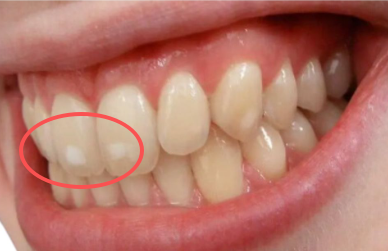
Your mouth is one of the most resilient environments in your entire body. It withstands extreme temperatures, a constant onslaught of bacteria, and the simple wear and tear of a lifetime of talking, laughing, and eating. So, when something changes in that familiar landscape—like the sudden appearance of small, white spots on your gums—it’s only natural to feel a jolt of concern. Your first thought might be, “Did I burn myself?” or “Is this just a canker sore?”
While it often is something minor, that little white spot is rarely random. It’s a direct message from your body, a bulletin posted on the most accessible public board it has. Learning to decode that message is one of the simplest yet most powerful things you can do for your health.
Here’s what your body might be trying to tell you.
The Message: “We’re Under Attack, But Holding the Line.” (Canker Sores)
This is the most common and generally harmless culprit. Medically known as aphthous ulcers, canker sores are small, shallow lesions with a white or yellowish center and a red border. They can appear on the gums, inside the cheeks, or on the tongue.
- What Your Body is Saying: “Our local defenses are a bit overwhelmed.” Think of a canker sore as a tiny, contained battlefield. Your body has identified a minor irritant or a breach in the mucosal lining and has launched a localized immune response. The white center is a mix of inflammatory cells and fibrin, a protein that forms a protective scab over the wound.
- Common Triggers: Stress, fatigue, a minor injury (from a toothbrush or a sharp piece of food), or even certain acidic foods (like citrus or tomatoes) can be the spark that ignites this small fire.
- Your Action Plan: Usually, none is needed beyond patience. They typically heal on their own within 7-14 days. Over-the-counter topical gels can provide pain relief. The message is to take it easy—your body is asking for a little less stress and a little more rest.
The Message: “We Have a Fungus Among Us.” (Oral Thrush)
If the white spots have a cottage cheese-like appearance and can be scraped off (often leaving a red, raw, or even bleeding base), your body is sending a different, more specific alert.
- What Your Body is Saying: “There’s an overgrowth of yeast in the ecosystem.” Our mouths naturally contain a small amount of a fungus called Candida albicans. Usually, our healthy bacteria and immune system keep it in check. But when that balance is disrupted, Candida can grow out of control, leading to a condition called oral thrush.
- Common Triggers: This message is often linked to a weakened immune system, the use of antibiotics (which kill protective bacteria along with the harmful ones), or uncontrolled diabetes. It’s also common in people who use steroid inhalers for asthma without rinsing their mouth afterward.
- Your Action Plan: This message requires a doctor or dentist’s interpretation. They will likely prescribe an antifungal medication. It’s a sign that your body’s natural balance is off, and it needs help restoring order.
The Message: “There’s Too Much Friction Here!” (Leukoplakia)
This message is more serious and demands your full attention. Leukoplakia (loo-koh-PLAY-kee-uh) appears as thick, white patches that cannot be wiped away. They often feel hardened or leathery.
- What Your Body is Saying: “This tissue is being chronically irritated, and it’s reacting by building up a defensive, callous-like layer.” This is your body’s last-ditch effort to protect the delicate tissue underneath from sustained damage.
- Common Triggers: The single biggest cause is tobacco use in any form (smoking, chewing). Other triggers can include chronic friction from ill-fitting dentures, broken teeth, or even a habit of chewing on your cheek.
- Your Action Plan: This is a non-negotiable signal to see your dentist or doctor immediately. While most leukoplakia is benign, a small percentage can show early signs of cancer. Your healthcare provider will need to examine the patch and likely perform a biopsy to rule out serious conditions. The message is clear: identify and eliminate the source of irritation now.
The Message: “Our Cell Regeneration is Going Haywire.” (Oral Lichen Planus)
This is a less common but chronic message. Oral lichen planus appears as a lacy, white, web-like pattern of lines on the gums or inside the cheeks. Sometimes it can also present as painful, swollen red patches.
- What Your Body is Saying: “Our immune system is mistakenly attacking the cells in our mucous membranes.” This is an autoimmune condition, meaning the body’s defense troops have gotten confused and are attacking its own territory.
- Common Triggers: The exact cause is unknown, but it can be associated with other autoimmune conditions, certain medications, or chronic stress.
- Your Action Plan: There is no cure, but a doctor can help manage the symptoms. This message is about long-term management, not a quick fix. It’s your body’s way of saying it needs a careful, holistic approach to health to keep the immune system as calm as possible.
The Most Important Message of All
A white spot on your gum is your body’s way of tapping you on the shoulder. Sometimes it’s a gentle tap to remind you to slow down. Other times, it’s a firm shake, urging you to seek professional help.
The most powerful thing you can do is listen. Don’t ignore it, and don’t self-diagnose. Make an appointment with your dentist or doctor. Point to the spot and say, “This is new. What is my body trying to tell us?” By becoming an active partner in interpreting these signals, you’re not just taking care of your mouth—you’re honoring a direct line of communication with your health.